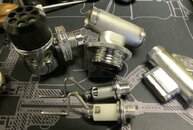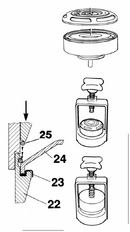Hello divers,
A friend of mine is selling his Cyklon. It’s likely pre 1995, so probably a Cyklon 300.
I should be able to get some photos of it in a few days. Not sure if it has the GSB 1/8” ports.
Is there anything specific I should know about these regulators, such as proprietary tools required?
I work as a sherwood/aqualung reg tech part time so I am familiar with the operating principles of most regs and the assorted terminology.
Just figured I might as well ask in advance, since there have been times that I have disassembled a reg and had a spring go flying (and never be found)
Thanks in advance,
Erik
A friend of mine is selling his Cyklon. It’s likely pre 1995, so probably a Cyklon 300.
I should be able to get some photos of it in a few days. Not sure if it has the GSB 1/8” ports.
Is there anything specific I should know about these regulators, such as proprietary tools required?
I work as a sherwood/aqualung reg tech part time so I am familiar with the operating principles of most regs and the assorted terminology.
Just figured I might as well ask in advance, since there have been times that I have disassembled a reg and had a spring go flying (and never be found)
Thanks in advance,
Erik





